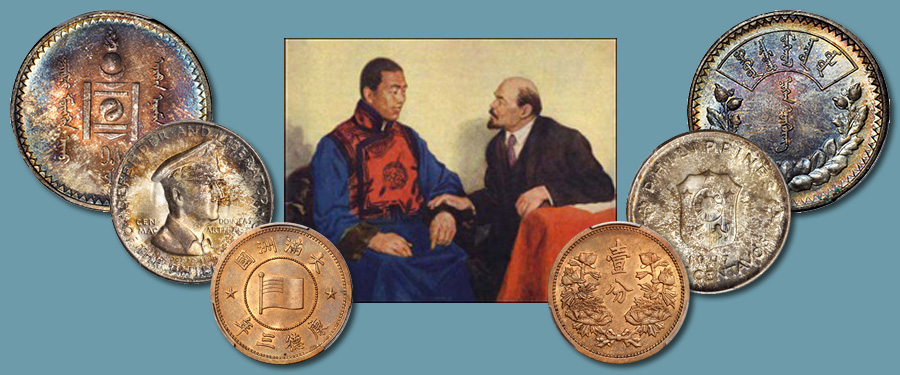
The Russian Revolution began in 1917 and culminated with a victory by the Bolsheviks in 1922 and the creation of the Union of Soviet Socialist Republics (USSR). This was not the only communist country to be formed in the 1920s. Revolution reached Mongolia in 1921 after a decade of political turmoil. Ruled by Qing Dynasty China until the collapse of the Chinese Empire in 1911, Mongolia descended into turmoil along with the rest of China. Using the pretext of the Russian Revolution, Republic of China troops occupied Mongolia beginning in 1919. In 1921, White Russian troops occupied Mongolia and a new independent theocratic government was established. As in Russia, a non-communist regime did not survive, and a Bolshevik Revolution broke out later in the same year, quickly establishing a new Socialist State in Mongolia. Unlike other revolutions in the Caucuses, Mongolia was able to retain independence, at least in name, from the newly formed USSR. Against this backdrop, the new Mongolian regime issued a first striking of coinage in 1925 (AH 15) including silver issues denominated 20 and 50 Mongo along with a Tugrik. Examples of these issues are presented in the December 1-3 Hong Kong Collectors Choice Online Auction.
The geopolitical situation of Mongolia shifted in 1931 with a new entrant onto the Asian mainland, Imperial Japan. Japan had achieved victory in the Russo-Japanese war that ended in 1905, had long maintained a presence on the Korean Peninsula and had economic rights to an area in Manchuria in Northeast China. Seeking to feed their imperial ambitions, Japan needed to expand economically during the nadir of the Great Depression. Using a pretext against the Chinese military, Japan began a full-scale invasion and occupation of their concession in China, establishing a puppet state called Manchukuo. This puppet government issued coins from the inception of Manchukuo until the end of the Second World War. A stunning Fen from 1936 can be found in our December sale. It was not long before border tensions erupted between the newly established Manchukuo and Mongolia, and by proxy the Soviet Union and Japan. After the full-scale invasion of China in 1937 by Japan, these tensions came to a head during a series of engagements that came to be known as the Battle of Khalkhin Gol, from which the Soviets secured a decisive victory and reinforced their claims about the location of Mongolia’s borders.
The defeat of the Japanese Army at Khalkhin Gol dissuaded that nation from taking any further immediate military action against the Soviet Union or Mongolia. Instead, the Japanese military, ever in need of oil, turned their attention southward to European colonial possessions in the South Pacific. The Japanese occupation of French Indochina had already enraged the United States and British Empire into placing crippling sanctions on Imperial Japan. When Japan’s focus fell upon the petroleum-rich Dutch East Indies, the Japanese high command was certain an attack on the Dutch possession would mean war with the United States and the British Empire. This decision made it easy for Japan to conclude a preliminary strike on the United States Pacific Naval Fleet was needed to ensure their Pacific objectives were met. This led to the attack on Pearl Harbor and the subsequent occupation of the Philippines and British, Dutch, and French possessions. Evidence of the cruelty of this occupation is displayed by the newly freed Philippines issuing a commemorative coin to honor Douglas MacArthur. Our December auction offers this item in the ultra-high grade of MS-66.
This series of events serves as evidence that no longer would local conflicts remain isolated in an increasingly connected world. A border skirmish in Mongolia could indirectly influence the course of events leading to a second theater of a global World War. Mongolia remained closely aligned with the Soviet Union until, like the USSR, communism gave way in 1992. The new democratic government in Mongolia created a new numismatic heritage, including a trio of gold commemoratives that prominently feature elements of Mongolia’s cultural heritage found in our December HK auction.
Our December 1-3, 2021 Hong Kong Online Auction of Asian Coins and Currency will be posted online for viewing and bidding in the coming weeks at stacksbowers.com. We are always seeking coins, medals, and paper money for our future auctions and are currently accepting submissions for our Official Auction of the January 2022 NYINC and our Spring 2022 Hong Kong auction. Additionally, we are accepting submissions for our Collectors Choice Online (CCO) auctions, the next of which will be in February. If you would like to learn more about consigning, whether a singular item or an entire collection, please contact one of our consignment directors today and we will assist you in achieving the best possible return on your material.





